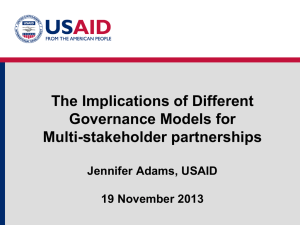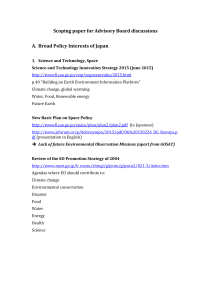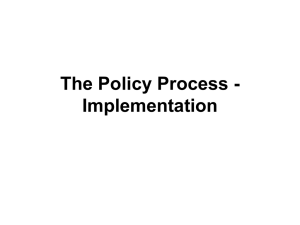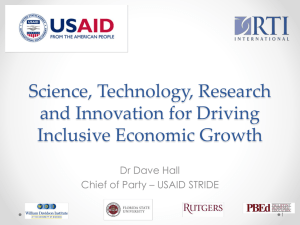Thematic Priorities
advertisement
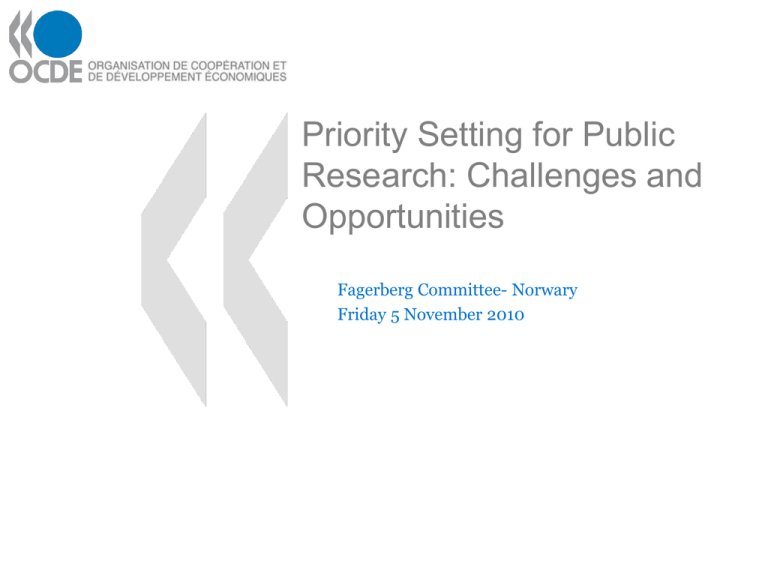
Priority Setting for Public Research: Challenges and Opportunities Fagerberg Committee- Norwary Friday 5 November 2010 Outline • • • • Recent trends Definitions and Rationales Mechanisms and instruments Challenges and opportunities Recent trends: Most countries have increased public R&D budgets between 2004-2009 (avg. annual growth) Recent trends (2) : Stimulus package measures relating to innovation and long-term growth Improving the infrastructure (e.g. roads, transport, ICT) Support for science, R&D and innovation Investment in human capital, education and training (including schools, teachers) Promoting investment in and uptake of «green» technologies and innovations to foster energy efficiency Support for innovation and entrepreneurship (incl. support for SMEs, venture capital) Recent trends in STI priorities: Environment, energy, health Strategic STI policy priority areas National security Austria Belgium (Flanders) Belgium (Wallonia) Canada Czech Republic Denmark Finland France Germany Hungary Israel Italy Japan Korea Netherlands New Zealand Norway Slovenia Spain South Africa Sweden Turkey United Kingdom United States Environment, Natural climate resources change and and oceans energy Food security n n n n n n n n n n n n n n n n n n n n n n n n n n n n n n n n n n n n n n n n n n n n n n n n n n n n n n n n n n n n Social Health & New challenges Engineering related life materials/ (incl. pension, and advanced sciences technologies transport, manufacturin (incl. (incl. urbanisation, g biotech.) nanotech.) housing) n n n n n n n n n n n n n n n n n n n n n n n n n n n n n n n n n n n n n n n n n n n n n n n n n n n n n n n n n n n n n Others 1 n n n n n n n n ICT Regional Children, influence, education tourism and and creativity culture n n n n n n n n n n n n n n n n n n n n n n n Definitions and Rationalities • Priority setting = selection of certain activities at the expense of others with an impact on the allocation of public resources • Rationales: – Primacy of Economic Efficiency Arguments • Instrumental rationality • Long term view • Stronger basis for accountability • Thematic areas where excellence can be built • Political Rationality or Narratives • Public research contribute to economic and social goals • Governance of STI • Whole of government approach • Stakeholder involvement Types of Priorities • Several classifications of types of priorities, among them the following two types: – Thematic Priorities: scientific fields; technoscience / technologies; sectors; issues; etc. – Structural Priorities: broadly, various innovation-related measures; more specifically, these might be concerned with research, teaching, firms, regulation, financing, networking and community-building, etc. • Priorities are set at different levels: – – – policy (government), strategic (research funding agencies), operational (research-performing institutes), i.e. the function of formulating and implementing S&T priorities (highly decentralised). Priority setting in an age of globalisation • Drivers for priority setting: – Open innovation, internationalisation of S&T, and increased international competition – Emergence of societal issues – ‘Global’ challenges (including sustainable development, climate change, alternative sources of energy, water supply, etc.) – requiring international collective action (and related governance frameworks) • Thematic priorities are increasingly shaped by – international agendas – economic rationales concerning international competitiveness (which tended to lead to much emulation / convergence in priorities rather than niche strategies) – Scientific excellence and critical mass • Issues: around governance; interface / interactions between foreign / supranational and national priorities Mechanisms of priority setting • Over time, a number of mechanisms have been applied in priority setting: – Technology planning and forecasting (1960/70s) – Technology foresight and roadmapping (1980/90s) – Priority setting and strategic policy intelligence (foresight, monitoring, evaluation, assessment, etc.) • Trend toward: – expertise-based consultation mechanisms – programmes (as distinguished from institutions) as vehicle of priority setting – increased decentralisation – as innovation systems have become more complex, a larger number of actors have built related capacities and been given responsibilities. However, the degree of (de)centralisation varies widely across countries Interest in priority setting tools • • Priority setting and related instruments, inducing strong demand for improved methodologies and international learning on best practices. Some examples – Austria – National dialogue combined with international peer review and assessment that identified gaps. Creation of working groups and identification of goals. Political will to develop a vision for 2020. – Chile – developed more “selective” policies through its clusters initiative. – Denmark – RESEARCH2015 aims to improve the basis for prioritisation of public funds for strategic research. – Germany – priority setting is highly decentralized but also involves strong dialogue between the government and the scientific community represented in research funding bodies and the publicly funded research performing institutions…….. Balancing “top-down” and “bottom-up” approaches • Top-down and bottom-up are not mutually exclusive, but an appropriate balance between them is required • Government / the top-down approach plays a role in – identifying ‘public interest’ areas as well as related potentials – formulating appropriate policy responses – promoting emerging areas (lacking vested interests), long-term ventures, multidisciplinarity, societal goals – forming and stabilising expectations • Bottom-up approaches – Elicit / gather / aggregate information – Express needs of stakeholders / “society” Some governance / stakeholder issues • Multiplicity of actors in priority setting – – – – – • • • • • Central ministries to funding agencies/PROs Public / private / non-profit funders Central versus regional governments Research Councils / Funding Agencies Research performers Communication among stakeholders Balancing functional / thematic priorities Accountability and co-ordination Direct vs. indirect channels of influence Limits to democratisation vs risk of technocratization – priority setting that escapes democratic processes Challenges in priority setting (1) • Underlying rationales for priority setting of public research – Beyond economic efficiency – Need for understanding role of public research and relation to growth • Balancing curiosity-driven vs. goal oriented research • Governance and involvement of stakeholders – Need for coherence in priority setting – but also need for taking into account the views and interests of different stakeholder groups • Linking priorities to outcomes and impacts – Links between funding and outcomes / impacts – Which criteria for priority setting and which tools? Challenges in Priority Setting (2) • National versus sectoral priorities • Strategic intelligence – Tension between need to know more for sensible PS <-> inherent limits to what one can know about future technological development • Priorities in an international context Opportunities for Priority Setting • Agenda setting for the future – Process for bring codified and distributed knowledge – Balance short-term and long-term concerns • Fostering synergies and economies of scope – Not only scale but scope • Fighting against institutional inertia – Improving adaptability • Building a broad-based and popular support for S&T • Policy learning – Identifying key drivers of change and opportunities Thank you for your attention Mario.cervantes@oecd.org Michael.Keenan@oecd.org Web Resou www.oecd.org/sti/innovation

